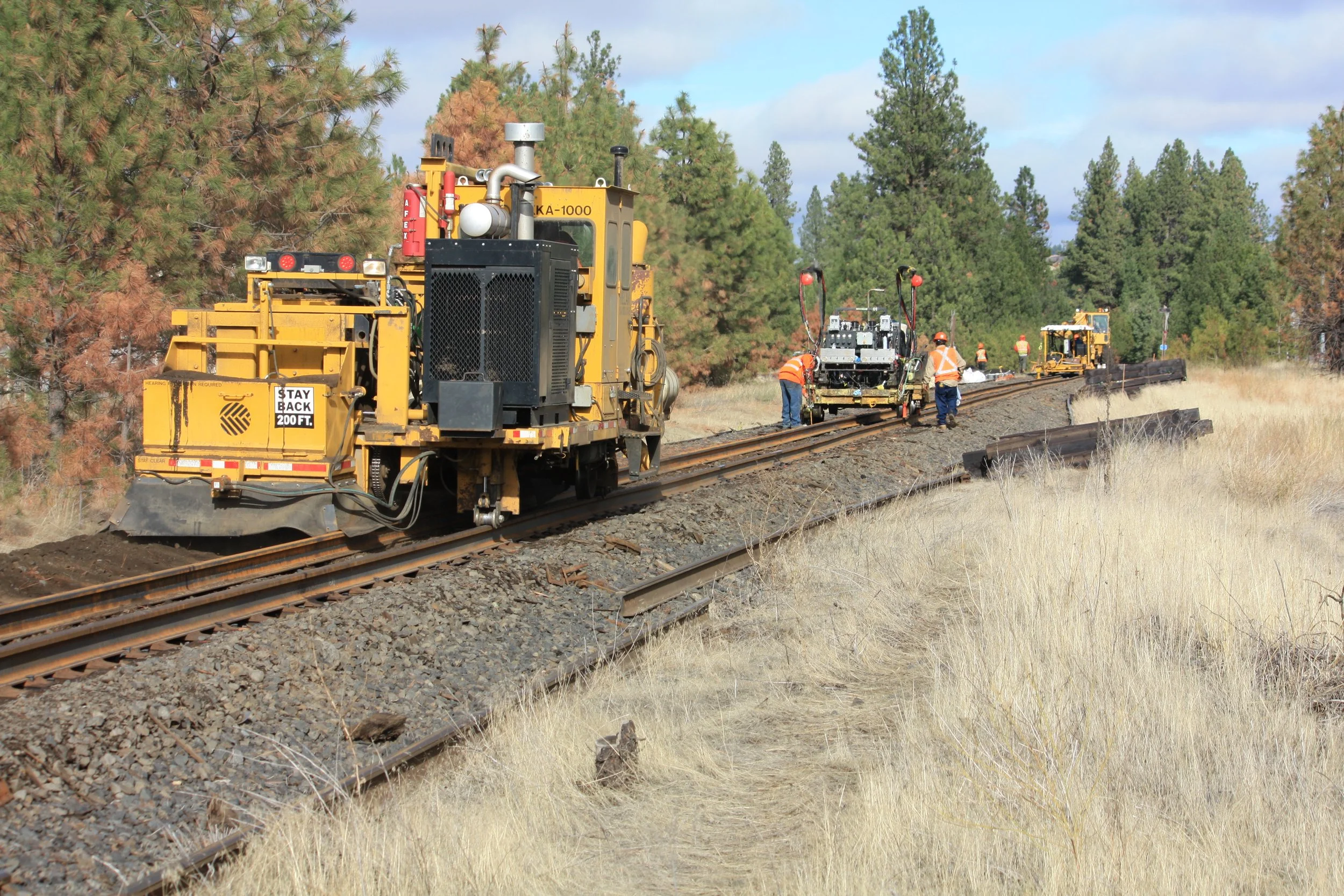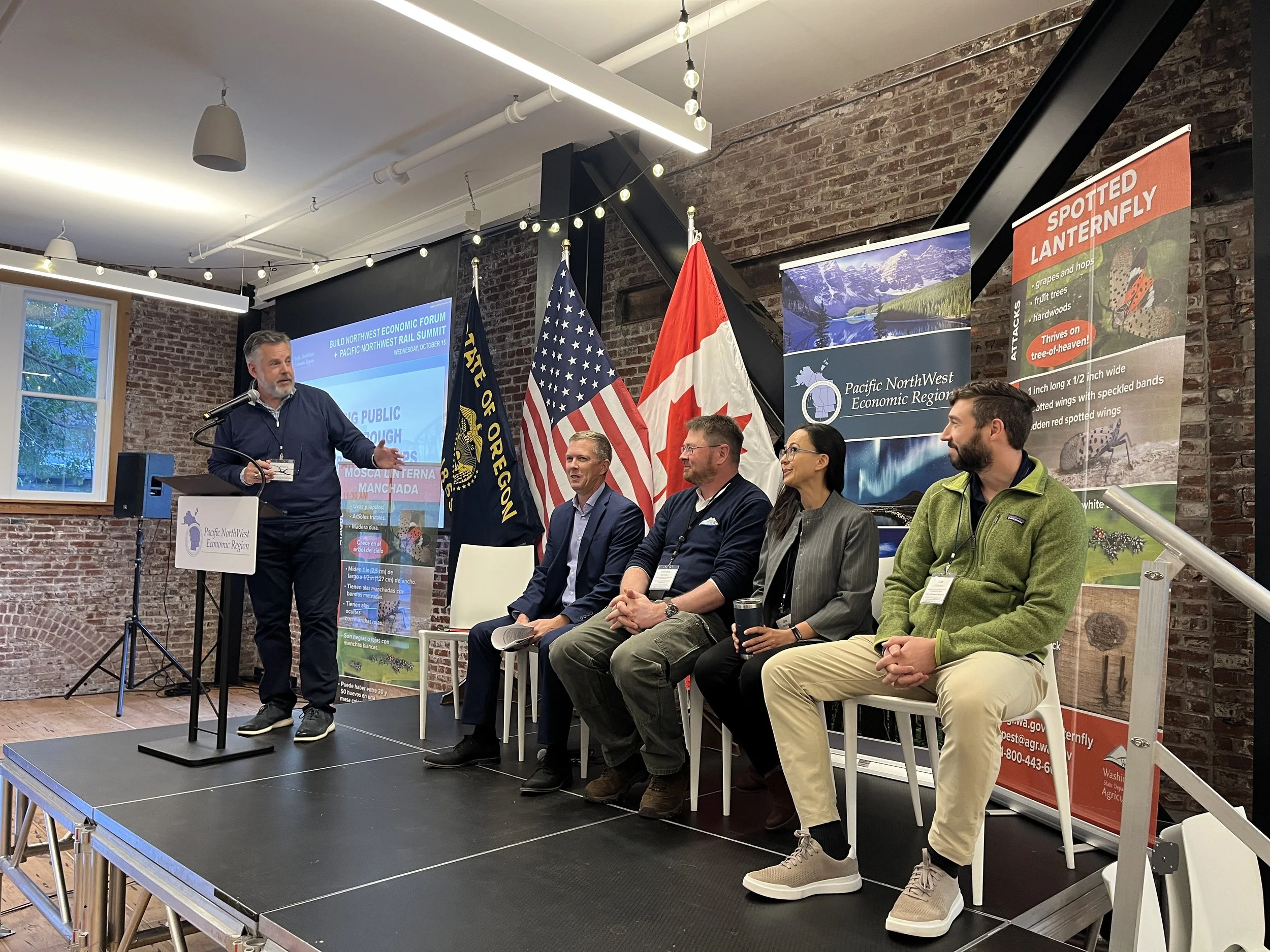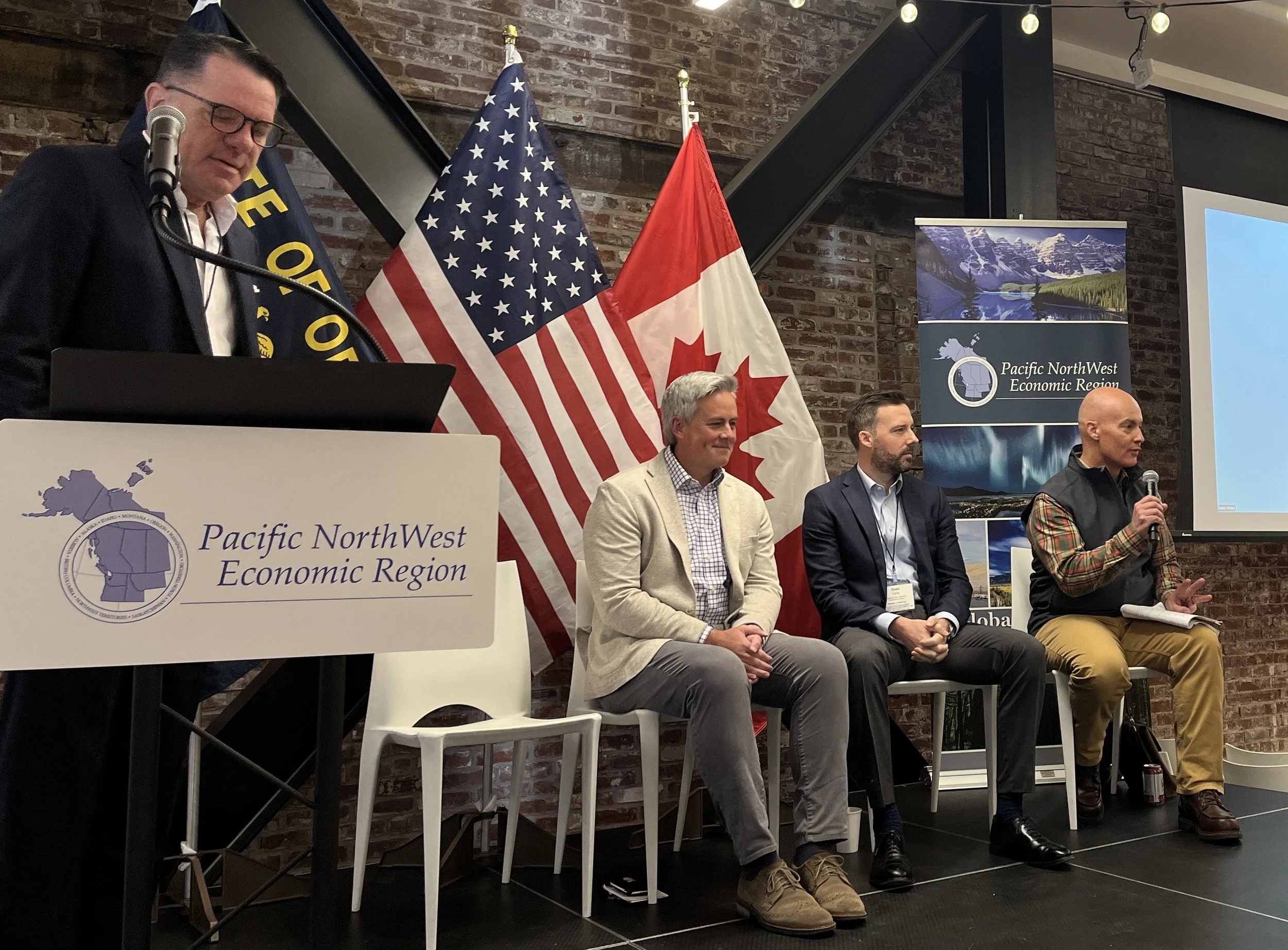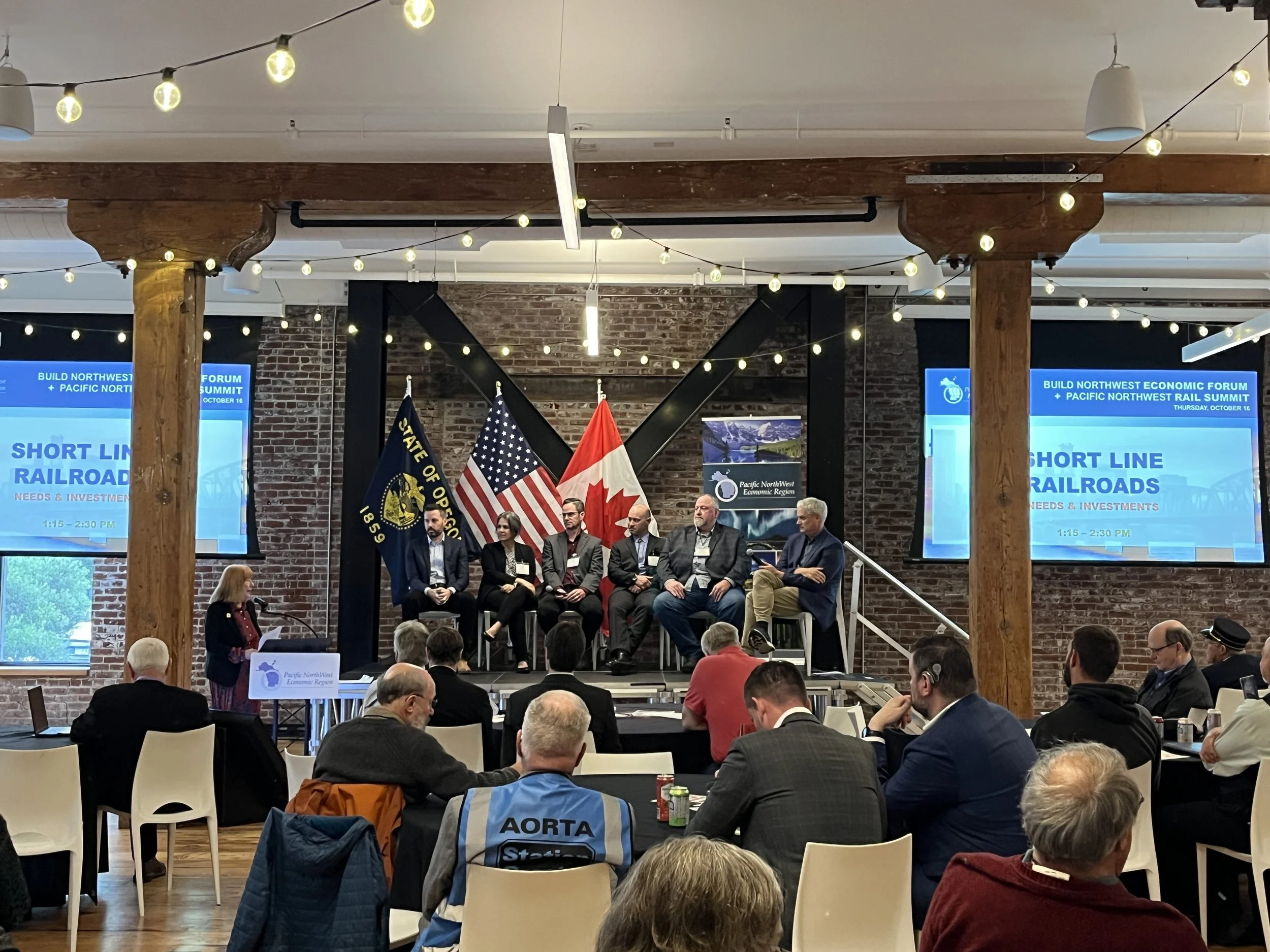Funding the Future of Rail: Innovative Tools and Partnerships Driving Rail Development
Our latest blog explores how innovative financing and public-private partnerships are helping to improve rail infrastructure for food, goods and passenger movement in the Pacific Northwest.
In recent rail news: The Port of Longview in late September on a $35.9 million loan from the USDOT Build America Bureau to boost freight capacity and relieve congestion on its Industrial Rail Corridor. This is a win worth celebrating, and it begs a bigger question: How do critical rail projects get funded, and what role do federal tools play alongside state, local and private investments? We’re continuing our ‘Who Pays For That?’ series by taking a closer look at how these systems coexist in our region, exploring innovative partnerships and highlighting creative models that are helping to keep our rail network resilient, connected and ready for the future.
Laying the Tracks: The Shared PNW Rail Network
In the Pacific Northwest, BNSF Railway and Union Pacific Railroad are the primary Class I freight railroad networks, to which smaller, short line railroads connect. Short line and regional railroads serve as the first- and last-mile carriers that link goods to the larger freight network.
Passenger train service runs primarily on infrastructure owned and operated by freight railroads. Take the Amtrak Cascades, for example, which runs between Vancouver, British Columbia and Eugene, Oregon on the BNSF and UP mainlines. Passenger rail operators serve as tenants of the freight rail network, and it takes constant coordination to balance the schedules of both service providers. This is an excellent example of private and public partners working in tandem to keep trains moving effectively for both goods and people.
Investment = Opportunity
Investing in our regional rail network unlocks tremendous benefits for businesses, farmers, producers, economies and communities. Because trains often run on the same tracks, strategic investments in one system benefit the other–and by extension, strengthen supply chains and community connectivity. This concept is at the core of our High Performance Rail initiative, which convenes diverse stakeholder groups and prioritizes joint investments that increase freight velocity and reduce passenger train delays.
Investments in these improvements come from blending private and public funds. As the primary owners of the network, freight railroads invest billions of dollars annually in private capital to maintain and improve the infrastructure. Investments from local, state and federal governments support complementary upgrades primarily to passenger rail, ports and short line railroads.
Leveraging Federal Financing Tools
Modernizing tracks, expanding capacity and improving passenger rail facilities often require upfront capital investment that can be difficult for railroads, shippers and municipalities to access independently. Federal financing programs can close this gap, offering tools that reduce costs and unlock investment in projects that deliver long-term economic benefits.
One flexible tool in the federal toolkit is the Railroad Rehabilitation and Improvement Financing (RRIF) program, administered by the USDOT Build America Bureau and offering long-term, low-interest loans and loan guarantees. Both public and private project sponsors are eligible for RRIF financing, and RRIF can finance up to 100% of a project. Recent program updates have made RRIF more accessible, with dedicated availability for transit oriented development (TOD) projects near train stations and RRIF Express for short line and regional railroad projects less than $150 million.
TIFIA for Rail
The Transportation Infrastructure Finance and Improvement Act (TIFIA), like RRIF, is a low-interest loan program issued by the Build America Bureau. While TIFIA is used primarily for surface transportation like highways and transit, it can enable rail project sponsors to leverage additional public and private funding, making it easier to fund large infrastructure projects upfront. In the Port of Longview’s case, TIFIA will be used in combination with federal, state and local funds to bolster track extension and development of supporting infrastructure.
Stacking Funding and Financing
Improving rail infrastructure doesn’t always come down to a single funding source. The projects are often made possible by stacking resources and blending federal loans and grants with state dollars and private investment. Let’s take a look at some local projects that used a mix-and-match approach to get across the finish line.
Rehabilitating Washington’s Longest Short Line Railroad
Guest authored by Jason Biggs, Director, WSDOT Rail, Freight and Ports Division
The Palouse River and Coulee City (PCC) Railway is owned by the state of Washington. It moves agricultural products from eastern Washington’s farms to export markets across the globe. In 2004, the previous private owner slated it for abandonment due to deferred maintenance. Recognizing its essential role in supporting Washington’s economy, the State Legislature directed WSDOT to purchase and rehabilitate the line.
Upon purchase, WSDOT determined its key goals were to replace defective rail, upgrade tracks to handle heavier railcars, and allow for higher speeds. This work is happening through state and federal funding, as well as over $80 million in private industry investments.
Beginning in 2015, the Legislature allocated $6.7 million every two years through 2031 for the PCC system. In 2022, the Legislature allocated an additional $150 million for PCC improvements. This allowed WSDOT to coordinate with stakeholders on project prioritization and to leverage state funding to apply for federal grants.
The PCC was awarded a $5.6 million federal BUILD grant in 2018 and in 2023 WSDOT secured a $72.8 million federal CRISI grant -- the nation’s largest CRISI grant ever awarded. In 2023, WSDOT was awarded an additional $37.7 million CRISI grant.
Thanks to the common vision of all parties, major improvements are now underway and the PCC system is a catalyst for economic prosperity in rural Washington. Images provided by WSDOT.
Moving Montana Forward with Federal-State Partnership
The Malta Corridor Operational Enhancement project is an $18.6 million initiative to improve railroad infrastructure on BNSF’s mainline in Malta, Montana, benefiting both freight and intercity passenger service. The project will eliminate critical bottlenecks, increase reliability and capacity for freight movement and improve the safety of local rail operations. Improvements will also support accessibility upgrades and other work at the Malta Amtrak station that serves the long-distance Empire Builder route.
The project leverages a unique funding model, combining FY22-23 grant funds from the USDOT’s Federal-State Partnership for Intercity Passenger Rail program with matching funds from BNSF and Amtrak. The State of Montana and Big Sky Passenger Rail Authority were key partners in this project that advances regional mobility and rural economic opportunities.
Public-Private Partnerships Support Critical Short Line Railroads
Guest authored by Ross Lane, Assistant Vice President, Government Affairs, Genesee & Wyoming
The economics and operations of short line railroads are fundamentally different than the larger Class I railroads. Short line railroads play a key role in moving goods the first and last mile and provide critical connections to Class I railroads who enjoy a broader national and international reach. These short line connections help businesses and communities maintain their ties to the national supply chain. Without rail service, many businesses would be forced to find alternative transportation options and subsequently absorb or pass along their higher transportation costs to their customers.
Grant programs, tax credits, and other financing mechanisms available to short line railroads enable small freight railroads to accelerate investments in their infrastructure, ultimately to the benefit of many railroad shippers. In turn, businesses can better compete in their markets and make investments in their businesses, thus completing the virtuous cycle. Grant programs and tax incentives also aid small railroads looking to attract new business by helping them complete large infrastructure projects. Oftentimes, transformational infrastructure projects are simply not possible without a public-private partnership because the railroad doesn’t generate enough revenue.
To ensure railroad customers maintain access to both domestic and international markets, short line railroads will need to continually evolve and invest in their infrastructure. New sidings, rail, ballast, and bridges will all need to be installed over time. Investment in short line infrastructure will also help accomplish the transportation goals for the broader PNWER region. Reducing wear and tear on public roads, improving supply chain resiliency, and attracting new businesses who rely on a safe and efficient freight rail system are the cornerstone of the short line industry. New and continued public-private partnerships will help make those goals a reality.
Talking Regional Rail Upgrades
Earlier this month, PNWER RIA Director Bruce Agnew travelled to Livingston, Montana for the annual conference of our project partner, Big Sky Passenger Rail Authority. The conference, themed ‘Turning our Stories into Action’, sparked productive discussion around rail service enhancements and restoration of service along the Big Sky North Coast Corridor – a rail line that served southern Montana between Seattle and Chicago before its discontinuation in 1979.
Agnew presented and participated in several panel discussions. During the “High Performance Rail Roundtable”, he shared updates on the PNWER RIA’s work with BSPRA and highlighted case studies of federal innovative financing tools accelerating critical rail infrastructure projects. Watch the presentation here.
Full Steam Ahead
Last week, the PNWER RIA team partnered with the Association of Oregon Rail and Transit Advocates (AORTA) to co-host the fourth annual Pacific Northwest Rail Summit in Portland, Oregon.
The event brought together policymakers and freight/passenger rail industry leaders to discuss investments, partnerships and opportunities for the future of the shared network. Our partners Big Sky Passenger Rail Authority, Oregon Rail Users’ League, Valley Regional Transit, All Aboard Washington and All Aboard Northwest were critical in amplifying these important regional conversations.
Key themes driving this year’s discussions:
Public-private partnerships unlock opportunities for investment in critical infrastructure
Collaborating across jurisdictions enables leaders to take coordinated action
Expanded intercity passenger service will better connect urban and rural communities across state lines
We’ll be continuing these conversations throughout the next year as we work to advance the region’s High Performance Rail network. Keep in touch by joining our working group via our contact form.
A detailed recap is coming soon. Visit pnwer.org/2025-forum in the coming weeks for presentations and session recordings.











